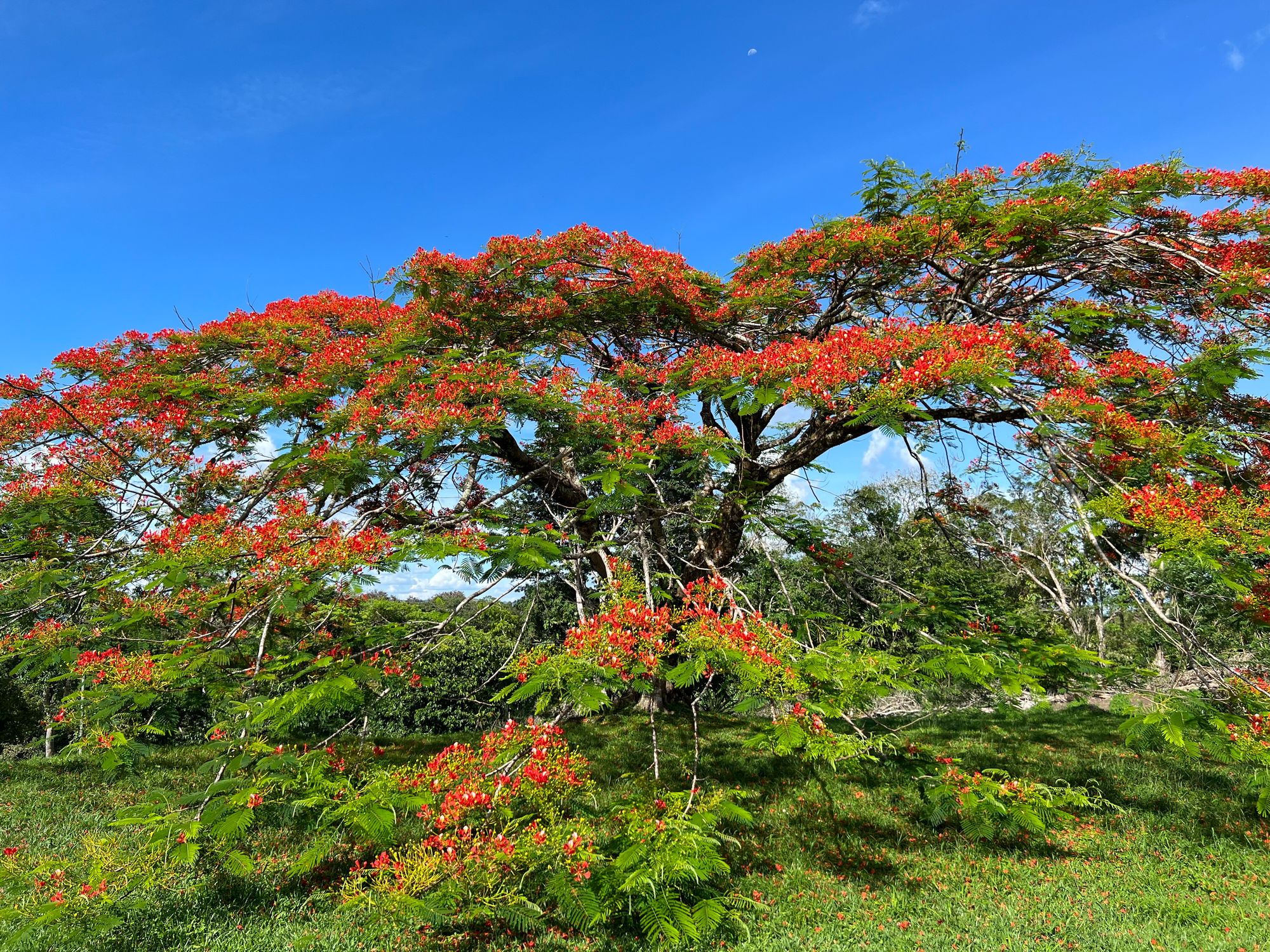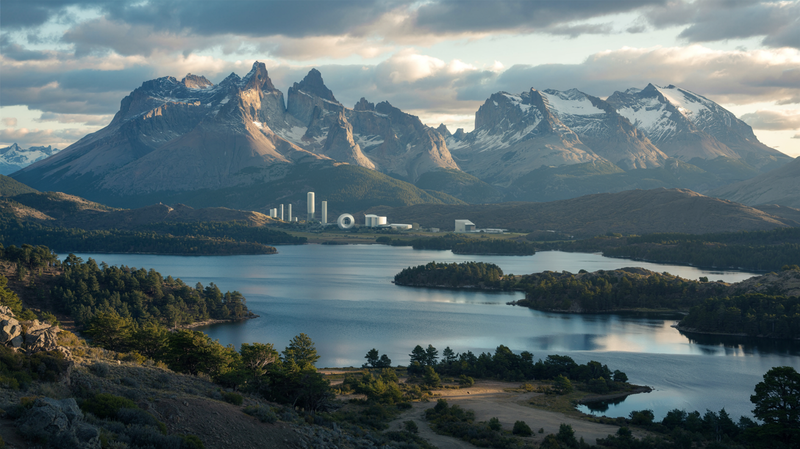The Flamboyant: Royal Poinciana in Costa Rica
The Royal Poinciana (Delonix regia), also known as the flamboyant tree, phoenix flower, flame of the forest, or simply flame tree, is a stunningly beautiful tree celebrated for its vibrant, flaming red-orange flowers. Originally from Madagascar, it has been widely cultivated in tropical regions around the world due to its
The Royal Poinciana (Delonix regia), also known as the flamboyant tree, phoenix flower, flame of the forest, or simply flame tree, is a stunningly beautiful tree celebrated for its vibrant, flaming red-orange flowers. Originally from Madagascar, it has been widely cultivated in tropical regions around the world due to its aesthetic appeal and shade-giving qualities. This tropical deciduous tree belongs to the pea family, Fabaceae, and is regarded as one of the most gorgeous tropical trees globally.
The Royal Poinciana can attain a height of up to 20 meters and spread 10-15 meters in diameter, with some exceptional specimens spreading up to 20 meters. It has a broad, umbrella-like crown that provides ample shade. The tree's fern-like, compound leaves lend it a soft, feathery appearance. However, the true allure of the Royal Poinciana lies in its flowers. These bloom in large clusters, with each flower having four spreading scarlet or orange-red petals, and a fifth upright petal called the standard, which is slightly larger and spotted with yellow and white.
The propagation of this tree is mainly through its woody legume pods, which can grow up to 60 cm long. The pods start as green and mature to a dark brown, housing several hard, woody seeds. These seeds can be dispersed by water or animals, enabling the tree to colonize new locations.
The Royal Poinciana arrived in Costa Rica, like many other tropical regions, through human intervention. Due to its striking beauty, it was imported as an ornamental tree for gardens and parks. The exact timeline of the Royal Poinciana's arrival in Costa Rica remains unclear, but it was likely during the colonial period when the exchange of plants between the Old and New Worlds was common.
Today, the Royal Poinciana is a common sight in Costa Rica, particularly in urban areas where it is planted along streets and in parks for its shade and beauty. It blooms between May and July, transforming the cityscape with its spectacular display of fiery colors. Despite not being native to the region, it has become an integral part of the urban and suburban landscape in Costa Rica.
However, it's important to note that while the Royal Poinciana is a beautiful addition to the landscape, it can become invasive under certain conditions. Its hardy nature and rapid growth can outcompete local flora, potentially disrupting local ecosystems. Therefore, its planting should be managed responsibly.
Nevertheless, the Royal Poinciana remains a cherished icon of tropical beauty, its fiery blossoms symbolizing the vibrant culture and lush landscapes of Costa Rica.
Costa Rica's Vibrant Culture: A Land Beyond the Flamboyant Tree
While the Royal Poinciana's fiery blossoms color the landscape, they are but a fragment of the vibrant culture and natural beauty that make Costa Rica an unforgettable destination. The Central American country is not only renowned for its rich biodiversity but also for its lively traditions, friendly locals, and flavorful cuisine.
Costa Rica is a country steeped in tradition. Its indigenous roots are still visible today in the Boruca tribe's vibrant masks and the Guaymi people's colorful textiles. The country's Spanish colonial heritage is also evident in its architecture, such as the ornate, neo-classical National Theatre in San José, and in its language, with Spanish as the national tongue.
However, Costa Rica's culture truly shines through in its festivals. The 'Fiestas Patronales', or patron saint festivals, are a highlight. Each town honors its patron saint with parades, music, dancing, and bullfighting events where the bull is not harmed. The 'Festival de la Luz', a December event in San José, features spectacular parades of floats, marching bands, and fireworks.
Then there is the 'Día de los Boyeros', or Oxcart Driver's Day, in Escazú, where beautifully painted oxcarts - a symbol of Costa Rica's agrarian past - are paraded through the streets. The intricate designs of these oxcarts were even recognized by UNESCO as a Masterpiece of the Oral and Intangible Heritage of Humanity.
The rich culture extends to the Costa Rican palate. The cuisine is a blend of native foods like corn, beans, and tropical fruits with Spanish influences. The national dish, 'Gallo Pinto', a mixture of rice and beans, is a staple at breakfast. Other traditional dishes include 'Casado', a hearty plate of rice, beans, plantains, salad, a tortilla, and a choice of meat or fish, and 'Tamales', a corn dough dish filled with meats, rice, and vegetables, traditionally wrapped in banana leaves.
Music and dance are also integral to Costa Rican culture. Whether it's the lively 'Cumbia' with its African rhythms and Spanish melodies, the traditional 'Merengue', or the popular 'Salsa', dance is a vibrant part of life.
Nature also plays a significant role in Costa Rican culture. The country is a global leader in conservation, with over a quarter of its land protected. Its commitment to sustainable tourism and renewable energy reflects the national philosophy of 'Pura Vida' - pure life. This phrase encapsulates the Costa Rican mindset of enjoying life slowly and appreciating the world's natural beauty.
Just as the Royal Poinciana has become an integral part of the landscape, so too have these cultural traditions become an indelible part of Costa Rican identity. From its vibrant festivals and delicious cuisine to its dedication to nature and the 'Pura Vida' lifestyle, Costa Rica offers a cultural richness as colorful and captivating as the blossoms of the flamboyant tree.





